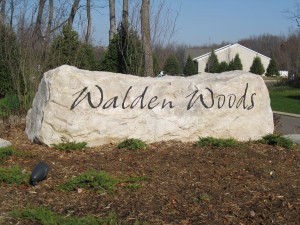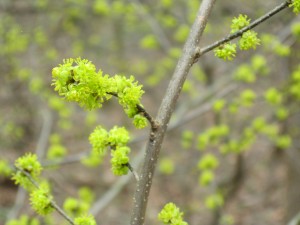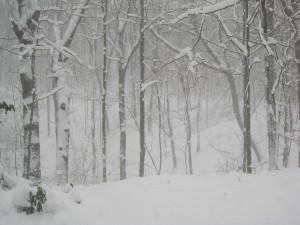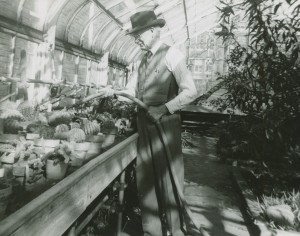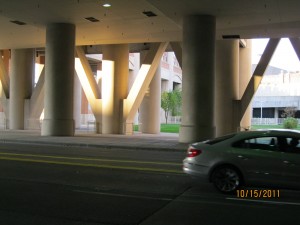
Title page of Walden by H. D. Thoreau, Heritage Press edition. Photo by Richard Brewer November 2012
The woods and meadows that so attracted [new residents] disappeared as soon as developers got around to building on them, and if the residents wanted to find what other nature features would be next to go, they had only to check the names of the subdivisions being planned. When a developer puts a woods into the name, or a vale, heights, forest, creek, or stream, he is not conserving; he is memorializing. Subdivisions are named for that which they are about to destroy.
–William H. Whyte
William Hollingsworth Whyte, called “Holly,” wrote those words in his 1968 book, The Last Landscape (Doubleday & Company). Whyte was many things–a keen and scientific student of human behavior, a planner and land conservationist, and an excellent writer. He was the primary architect of the conservation easement, currently the most widely used method of private land conservation.
Whyte may not have been the first person to notice that developments tend to be named after the natural features they damage or obliterate, but I’m pretty sure he was the first prominent conservationist to state it as a rule. Most of us can come up with local examples. If we saw an ad for lots in a new development called the Preserve at Eagle Knoll, we would win more often than we lost if we bet that the knoll had been flattened, the eagles were gone, and nothing was preserved.
Recently, I came across a related but slightly different approach to naming developments right here in Kalamazoo.
A good many years ago, Western Michigan University bought some property a little beyond the west edge of the campus. The property, sometimes held in the name of the WMU Foundation, adjoined a city well-field and the Arcadia plat and lay between Solon Street on the east and Drake Road on the west. WMU had bought the land thinking they were going to need a bigger, grander football stadium, but the need didn’t materialize, and it turned out that the cost of such a project, especially the required utilities, was prohibitive.
The land, which for convenience can be referred to as the Arboretum, was mostly recovering agricultural fields but with a few relict patches of native vegetation. On the northwest side of the property grew a few bur oaks of various sizes. This was near the south edge of one of the eight tall-grass, black soil prairies of the county–Grand Prairie–and these trees were a heritage of the fringing bur oak plain.
Also on the north boundary but farther east was a small pocket, a little valley, of mesic forest, but an unusual type of mesic forest with few or no beeches or sugar maples, dominated instead by basswood trees. Part of this little valley was on the WMU property, the rest on the parcel adjacent to the north.
For a good many years the land abided, the plants and animals cycling through the seasons, visited by no one except walkers and joggers, bird-watchers and berry-pickers, and an occasional ecology class.
Several years ago, things began to change. Someone interested in the sequence and timing could probably work out the details from the Kalamazoo Gazette mlive archives if they wanted to spend the time. Here’s a place to start. A quick synopsis is that WMU wanted to monetize their land holdings, and the city of Kalamazoo desperately wanted an east-west street in the region. Other business and governmental entities were or became involved. The Kalamazoo School system built a new middle school. The city built a road, which they called a parkway, crossing the property from Drake Road to Solon Street. I’ve never known just what a parkway is, but a prominent feature of this one is that there is no place to park along it. One result is that access to the arboretum for walkers is pretty much limited to some of the immediate neighbors.
And the land began to be developed. A couple of months ago, I saw signs for a new condominium development. The literature on it mentions that it will be “set amidst 80 acres of woodlands and rolling meadows–of which 40 acres will be preserved.” Just how preserved it will be is unclear; so also are who and what it’s preserved for. The literature goes on with a set of bullet points one of which is “40 acres of private green space.”
The name of the new development: Walden Woods.
Perhaps I’m jumping to a conclusion, but the name suggests a connection to Henry David Thoreau, the famous naturalist, conservationist, and environmentalist. In an earlier post, I quoted a characteristic passage from Thoreau’s journal that also pertains here:
Each town should have a park, or rather a primitive forest, of five hundred or a thousand acres, where a stick should never be cut for fuel, a common possession forever, for instruction and recreation…. All Walden Wood might have been preserved for our park forever, with Walden [pond] in its midst….
In Kalamazoo’s case, the 180+ acres of the Arboretum could have been turned into a city park–badly needed in this area of the city–along with an adjoining nature preserve. Something of this sort is what most of the neighbors and many other Kalamazoo residents wanted. But, that, of course, is exactly what did not happen. Instead, we have what we have, which includes Walden Wood in the form of a condo development.
It’s hard not to see this as another sad example of Whyte’s rule. But perhaps we should try to take a little cheer from the situation. For example, if other developments follow in the arboretum, the names of dozens of other conservationists and conserved natural areas are waiting to serve. With Walden Woods honoring Thoreau, it would be only fair to have a Muir Woods for John Muir. One of these already exists, but California is a long way from here so probably there would be no confusion.
Among Teddy Roosevelt’s many conservation achievements, he set aside the first-ever bird sanctuary, Pelican Island. How about Pelican Arboretum as a general name for the whole site?
